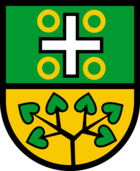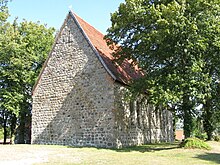Big wokers
| coat of arms | Germany map | |
|---|---|---|

|
Coordinates: 53 ° 45 ' N , 12 ° 30' E |
|
| Basic data | ||
| State : | Mecklenburg-Western Pomerania | |
| County : | Rostock | |
| Office : | Mecklenburg Switzerland | |
| Height : | 54 m above sea level NHN | |
| Area : | 21.91 km 2 | |
| Residents: | 1011 (Dec. 31, 2019) | |
| Population density : | 46 inhabitants per km 2 | |
| Postal code : | 17166 | |
| Area code : | 039978 | |
| License plate : | LRO, BÜZ, DBR, GÜ, ROS, TET | |
| Community key : | 13 0 72 040 | |
| Office administration address: | von-Pentz-Allee 7 17166 Teterow |
|
| Website : | ||
| Mayor : | Heike Wachowiak | |
| Location of the community of Groß Wokern in the Rostock district | ||
Groß Wokern is a municipality in the southeast of the Rostock district in Mecklenburg-Western Pomerania (Germany). The municipality is administered by the Mecklenburg Switzerland Office with a shared seat in Jördenstorf and the non-official city of Teterow .
geography
The municipality of Groß Wokern is located in the west of Mecklenburg Switzerland , the southern part of the municipality is in the Mecklenburg Switzerland and Kummerower See nature reserve . Groß Wokern is about six kilometers from the city of Teterow. The municipality is hilly and reaches 84 m above sea level in Badenberg near the district of Nienhagen. NN.
Groß Wokern is surrounded by the neighboring communities Groß Roge in the north, Teterow in the northeast, Hohen Demzin in the east, Dahmen in the south and Lalendorf in the west.
Community structure
The municipality includes the districts of Klein Wokern, Groß Wokern, Neu Wokern, Nienhagen, Uhlenhof and Waldschmidt.
history
Until the 19th century
Groß Wokern was probably founded in the 12th century.
In 1773 the field marrow of large and small wokers was measured. The field register indicated an area of 445,355 square rods (965 hectares) for Groß Wokern. The first Büdner posts were probably set up with this survey . In 1777 the school regulations issued for the domanium made school attendance in Groß Wokern compulsory. In 1785, Groß Wokern was re-measured and divided into twelve hoof positions. In 1792 the windmill on Nienhäger Weg burned to the ground. On November 3, 1806, French troops looted the village on their march through. In the census on July 30, 1819, 328 inhabitants were counted.
From 1822, the temporary lease was gradually replaced by the long lease . The farmers with new long-term leases relocated their homesteads from the village center to the separated Hufen and made room for tiers. Only a few farms remained in the village. The new courtyards were built as three-sided farmsteads in brick . The barns were still thatched. The Low German farmhouses disappeared from the village scene.
20th century
After 1945 there was a Soviet military headquarters in Groß Wokern in the building of the current kindergarten and former elementary school. On the right and left of the building there are still faint Russian inscriptions; they were meant to express that there was a fight against fascism and war, but not against the people.
The existing windmill in the village burned down after 1947; the subsequently erected electric mill was not fully commissioned.
On July 1, 1950, the previously independent municipality of Nienhagen was incorporated.
During the GDR era, the community of Groß Wokern was part of the Groß Roge community association. In the 1980s, in addition to the existing polytechnic high school from the 1960s, another, larger school building and a new gymnasium for the school as well as two new buildings were built near the cultural center. The culture house, the first new building and the large sports field were also built in the 1960s.
For decades, the Groß Wokern brickworks, which was founded in 1896 and located at Neu Wokern train station, was one of the most important businesses in the village. The clay was brought from the clay pit to the brickworks on a wagon from the northern edge of the village. When clay mining ended in the early 1980s, the railway was dismantled and the brickworks converted into a metal processing company.
Also in the 1980s, a larger housing estate was built in Groß Wokern on the road from Teterow to Klaber . In the village there was a consumer outlet, an HO shop , a library, a post office and a hairdresser.
The district of Nienhagen was declared a "village of youth" in the 1980s. In order to recruit urgently needed workers for agriculture, there were campaigns to bring young people into the village and to keep them there, which, however, had little success. This included an art exhibition, writers' reading and also a motocross race and the founding of the Nienhagen Motor Club. Delegations from Cameroon were even led through the “Village of Youth”.
politics
coat of arms
Blazon : “Divided; above, in green, a floating silver bar cross, angled by four golden rings; below in gold a black linden branch with six green leaves. "
The six green leaves symbolize the six districts.
flag
The municipality's flag is evenly striped lengthways in gold (yellow) and green. In the middle, at two-thirds of the height of the golden (yellow) and green stripes, is the municipal coat of arms. The length of the flag is related to the height as 5: 3.
Attractions
- church
- The late Romanesque stone church in Groß Wokern on the southern edge of the village on the Honigberg was built between 1240 and 1260. The two-bay , single-nave nave has slotted windows and a simple arched portal on the north side . The rectangular, recessed choir with domed vault and pointed triumphal arch has a group of windows with Romanesque round arches on its east wall . The domed cross rib vaults in the nave were built in later. The bell is located outside the church, the support structure was renewed in the 1990s.
- The organ was built in 1894 by the court organ builder Carl Börger from Gehlsdorf near Rostock and has been a permanent fixture in the church ever since. It has thirteen registers (mechanical slider drawer organ based on the Friese technology). In 1945 the organ was destroyed by vandalism. At the initiative of committed Christians in the village, the reconstruction took place in 2011 and the rededication of the instrument on Palm Sunday 2012. It is now the largest surviving organ from Carl Börger.
- Klein Wokern manor; One-storey, 9-axis plastered building with a large half-hip roof with bat dormers
- Memorial to the fallen from the First World War on the village square
→ See also the list of architectural monuments in Groß Wokern
Economy, transport and infrastructure
economy
Due to the moderate building land prices, many private homes could be built after reunification , especially between Groß Wokern and Neu Wokern train station.
Since the mid-1990s , numerous companies (a construction company, a safe construction company, a shelf construction company, a window construction company, a farm computer company, etc.) have settled in the municipality's industrial area ("Am Steinbrink", near the Bundesstraße 104 ) in the Neu Wokern district ). The former Federal Chancellor Helmut Kohl visited the industrial park shortly before he was voted out of office in 1998 and had a safe made for him.
traffic
The federal road 104 from Güstrow to Teterow touches the northern edge of the municipality near Klein Wokern. The connecting road from Teterow to Krakow am See runs through Groß Wokern. The Güstrow and Krakow am See junctions are both 13 kilometers away on the Federal Highway 19 (Rostock-Berlin).
Groß Wokern is part of the Warnow transport association . The Neu Wokern stop is on the Bützow – Szczecin railway line . The regional express Lübeck - Szczecin and the trains Bützow - Ueckermünde of the DB Regio run every two hours . There are hourly direct connections to Teterow, the district town of Güstrow and the regional center of Neubrandenburg . Several bus lines operated by the Güstrow bus company connect Groß Wokern with Teterow, Güstrow and Krakow am See, among others.
Facilities
Today (2019) Groß Wokern has a primary school, a day care center, a retirement home, a doctor's practice, physiotherapy, a hardware store, a restaurant and a cultural center. In the vicinity of the village there is the Schillersee with several bathing places and numerous boathouses.
literature
- Gerhard Voß : The Church of Groß Wokern in its historical contexts (1981) , in: Michael Bunners, Erhard Piersig (Ed.): Yearbook for Mecklenburg Church History - Mecklenburgia Sacra, Volume 16 , Wismar: Redaria 2013, pp. 9-23.
Web links
Individual evidence
- ↑ Statistisches Amt MV - population status of the districts, offices and municipalities 2019 (XLS file) (official population figures in the update of the 2011 census) ( help ).
- ↑ http://www.heimat-mecklenburgische-seenplatte.de/kirchen/lk-rostock/k-gross-wokern/k-gross-wokern.htm






